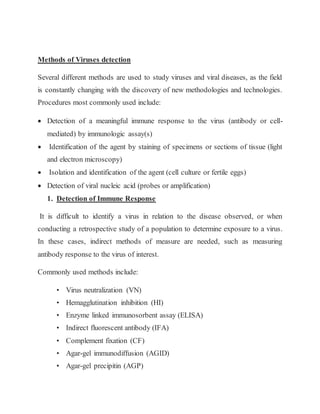Methods of Viruses detection.
Several methods are used to detect viruses, including detecting the immune response to viruses, identifying viruses using microscopy techniques, isolating viruses using cell culture or eggs, and detecting viral nucleic acids. Commonly used methods to detect the immune response include virus neutralization, ELISA, and complement fixation assays which detect antibodies binding to viral antigens. Light microscopy can identify viruses labeled with fluorescent or peroxidase indicators, while electron microscopy at higher magnifications allows viewing individual viral particles. Isolating viruses in cell cultures or eggs allows identification by characteristic changes to cells, though molecular detection of viral genomes is now more popular and sensitive.

Recommended
Recommended
More Related Content
Similar to Methods of Viruses detection.
Similar to Methods of Viruses detection. (20)
Recently uploaded
Recently uploaded (20)
Methods of Viruses detection.
- 1. Methods of Viruses detection Several different methods are used to study viruses and viral diseases, as the field is constantly changing with the discovery of new methodologies and technologies. Procedures most commonly used include: Detection of a meaningful immune response to the virus (antibody or cell- mediated) by immunologic assay(s) Identification of the agent by staining of specimens or sections of tissue (light and electron microscopy) Isolation and identification of the agent (cell culture or fertile eggs) Detection of viral nucleic acid (probes or amplification) 1. Detection of Immune Response It is difficult to identify a virus in relation to the disease observed, or when conducting a retrospective study of a population to determine exposure to a virus. In these cases, indirect methods of measure are needed, such as measuring antibody response to the virus of interest. Commonly used methods include: • Virus neutralization (VN) • Hemagglutination inhibition (HI) • Enzyme linked immunosorbent assay (ELISA) • Indirect fluorescent antibody (IFA) • Complement fixation (CF) • Agar-gel immunodiffusion (AGID) • Agar-gel precipitin (AGP)
- 2. • Latex agglutination (LA). The principles of these assays are fundamentally the same, they depend upon antibody-antigen interactions and consist of a known virus or viral protein, a patient sample (usually serum), and an indicator. If antibodies are present in the patient’s serum, they will bind to the virus. If no antibodies are present, no binding will occur. The indicator is observed to determine whether the sample is positive or negative for antibodies 2. Light and Electron Microscopy Light Microscopy Viruses, unlike bacteria, are too small to be seen using a standard light microscope. Therefore, antibodies labeled with an indicator, most frequently peroxidase or fluorescence, designed to identify the virus of interest are used. This will enables the visualization of the virus cluster (with the light microscope, in the case of peroxidase, or an ultraviolet (UV) light microscope in the case of fluorescence. Electron Microscopy Another way to identify a virus is with the use of the electron microscope. Since viruses are much smaller than bacteria, a regular light microscope does not provide sufficient magnification to see them. The magnification of an electron microscope (50,000x magnified) provides the ability to see the viral particles. Virus Isolation The first step in identification of a viral infection often involves the ability to isolate the virus. The two most commonly used methods are cell culture and fertile chicken eggs.
- 3. Isolation methods are less specific and whatever can grow will show characteristic changes in the cells from the control (normal) cells. Virus isolation is often a very slow and labor intensive process, thus alternative tests are constantly being developed. Molecular methods The most popular tests at this time are molecular methods, such as polymerase chain reaction (PCR) and real-time polymerase chain reaction. With the increased availability of molecular tests, fewer diagnostic laboratories attempt virus isolations. Molecular methods do not rely on the presence of a live virus like virus isolation procedures. These methods detect a piece of the viral genome, making them more sensitive for the detection of viruses.